International Journal of Modern Education and Computer Science @ijmecs
Статьи журнала - International Journal of Modern Education and Computer Science
Все статьи: 1123
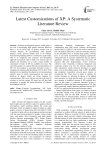
Latest customizations of XP: a systematic literature review
Статья научная
Software development process model plays a key role in developing high quality software. However there is no fit-for-all type of process model exist in software industry. To accommodate some specific project’s needs, process models have to be tailored. Extreme Programming (XP) is a well-known agile model. Due to its simplicity, best practices and disciplined approach researchers tried to mold it for various types of projects and situations. As a result a large number of customized versions of XP are available now days. The aim of this paper is to analyze the latest customizations of XP. For this purpose a systematic literature review is conducted on studies published during 2013 to 2017. This detailed review identifies the objectives of customizations, specific areas in which customizations are done and practices & phases which are being targeted for customizations. This work will not only serve the best for scholars to find the current XP states but will also help researchers to predict the future directions of software development with XP.
Бесплатно
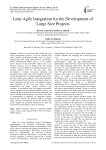
Lean agile integration for the development of large size projects
Статья научная
Scrum is a well-known agile model due to its strong management practices. It can be mingled with many software development models such as extreme programming (XP), Agile Unified Process, and Feature Driven Development (FDD). Lean is a very popular known process in the automobile industry due to its effective practices such as Kanban bard and smooth workflow. Lean development is gaining popularity in the software industry from the last few years. Lean development is rational, convenient, responsive, and team-based and it adds value to the enterprise. Scrum is useable and practical for small and medium projects but it does not render positive support for the large size projects. In order to adopt Scrum for large size projects, there is a need to integrate Lean and Scrum. It is required to inherit some properties of the Lean into Scrum, without compromising the speed, quality, efficiency, and standards, to accomplish large size projects successfully such as enterprise resource planning (ERP) systems. It is anticipated that the proposed Lean Scrum integration will make it suitable to develop large size projects. The same is accomplished by purposing an integrated LScrum model in this research. The proposed model is validated using a survey to conclude the results. The results of the survey support the proposed integration of Lean and Scrum for the development of large size projects.
Бесплатно
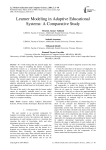
Learner Modeling in Adaptive Educational Systems: A Comparative Study
Статья научная
It's worth noting that the present paper lies within the range of modeling the learner in adaptive educational system as a conceptual modeling of the learner. Thought they are several methods that deal with the learner model; like stereotypes methods or learner profile…, but they are likely unable to handle the uncertainty embedded in the dynamic modeling of the learner. The present paper aims at studding different models and approaches to model the learner in an adaptive educational systems, and coming up with the most appropriate method based on the dynamic aspect of this model. The aim of this study is the argue that the learner model cannot be completely modeled based on one single method through the entire development process, but it needs a combination between several methods that will help for a complete modeling.
Бесплатно
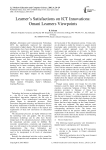
Learner's Satisfactions on ICT Innovations: Omani Learners Viewpoints
Статья научная
Information and Communication Technology (ICT) has significantly improved the educational environment to higher degrees. The teaching and learning methodologies have been changed to greater extends to motivate the instructors and learners. The learner's satisfaction on these ICT innovations depends on their impact in day to day knowledge gaining processes. This paper discusses some major ICT factors that influence the Omani learners and their corresponding satisfaction levels. This research also identified that these technological innovations motivate the learners in self-learning and in future continuing education. The study identified that the overall significant development educational processes and encouragement in the learning processes by information and communication technology innovations have higher impacts on the learners' satisfaction.
Бесплатно
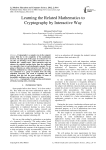
Learning the Related Mathematics to Cryptography by Interactive Way
Статья научная
Cryptography is a complex area in the computer science field due to the complexity of the mathematics involved. The main goal of this paper is to discuss how we can take an advantage of the online interactive tools to facilitate this complex topic. These interactive tools can enhance the students learning better than the traditional way especially when we teach mathematic concepts. We are going to illustrate an online interactive tool that uses the Modular Arithmetic in a virtual environment. A case study was conducted on a group of students from the King Abdulaziz University. The result of evaluating the tool indicates that this tool has good usability in terms of learnability, usefulness, ease of use, and outcome.
Бесплатно
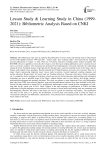
Lesson Study & Learning Study in China (1999-2021): Bibliometric Analysis Based on CNKI
Статья научная
The students' psychological health in high education is still being a problematic issue. This article describes the importance of ensuring students' psychological health in higher education today and related empirical research results. The aim of this paper is exploring and analysis research results focused on students' psychological health. To determine the students' psychological health there were used special psychodiagnostic methods. The components of the psychological health were divided as 1) satisfaction level; 2) perceptions of a healthy lifestyle; 3) emotional stability; 4) psychoemotional state; and 5) attitude towards themselves. Obtained results on students' psychological health indicate specific conclusions about various psychological health indicators and the relationship between behaviour and internal health, including in emotional, cognitive and behavioural areas. The results of this research work showed that one of the important indicators of students' psychological health is a decrease in the level of emotional distress and emotional instability (neuroticism, nervousness), a positive change in students' internal state, and an increase in students' satisfaction with their educational environment. The results could be used in the high education system, especially measuring and monitoring students' psychological health.
Бесплатно
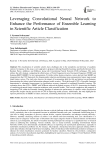
Статья научная
The classification of scientific articles faces challenges due to the complexity and diversity of academic content. In response to this issue, a new approach is proposed, utilizing Ensemble Learning, specifically Decision Tree, Random Forest, AdaBoost, and XGBoost, along with Convolutional Neural Network (CNN) techniques. This study utilizes the arXiv dataset, comparing the effectiveness of Term Frequency-Inverse Document Frequency (TFIDF) and Sentence-BERT (SBERT) for text representation. To further refine feature extraction, vectors derived from SBERT are integrated into the CNN framework for dimensionality reduction and obtaining more representative feature maps named latent feature vectors. The study also observes the impact of incorporating both the title and abstract on performance, demonstrating that richer textual information enhances model accuracy. The hybrid model (CNN + Ensemble Learning) demonstrates a substantial improvement in classification accuracy compared to traditional Ensemble Learning. The evaluation shows that CNN + SBERT with XGBoost achieved the highest accuracy of 94.62%, showcasing the benefits of combining advanced feature extraction techniques with powerful models. This research emphasizes the potential of integrating CNN within the Ensemble Learning paradigm to enhance the performance of scientific article classification and provides insights into the crucial role of CNN in improving model accuracy. Additionally, the study highlights the superior performance of SBERT in feature extraction, contributing beneficially to the overall model.
Бесплатно
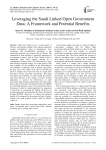
Leveraging the Saudi linked open government data: a framework and potential benefits
Статья научная
Open data initiatives are a crucial aspect of effective e-governance strategy. They embody aspirations towards sociopolitical values of transparency, trust, confidence, and accountability, pertaining to the relationship between a government and its citizens. The importance of such initiatives is especially important for an emerging economy such as Saudi Arabia which is undergoing rapid social changes directed by a contemporary national vision. The effectiveness of open data initiatives depends strongly on (a) the quality of the data available, (b) the soundness of the methodologies and suitability of platforms used to prepare and present the data, and (c) the ability of the data to facilitate the kinds of insights and social-action that are sought from that data to ensure successful e-governance. This paper investigates the feasibility of current Saudi government open data initiatives in this regard. It assesses existing approaches to improve the effectiveness of open government data through transforming it into linked-open data (using the Resource Description Framework [RDF]) by connecting disparate sources of structured data therein. It proposes to improve existing approaches by suggesting a framework for automating the linking sub-process of existing approaches and organizing the data to be queried through SPARQL. Moreover, it evaluates the potential benefit of this proposal by discussing the kinds of policy insights this could generate which would be difficult without it.
Бесплатно
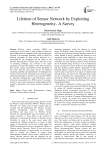
Lifetime of Sensor Network by Exploiting Heterogeneity- A Survey
Статья научная
Wireless sensor networks (WSN) are emerging in various fields. A large number of sensors in these applications are unattended and work autonomously. Lifetime is an important parameter which is critical for different algorithms for data transfer. Moreover it is responsible for the throughput and the failure of the network. Heterogeneous wireless sensor network, on top of clustering technique, has evolved as the major parameter to increase the lifetime of the Sensor network, data transfer, energy consumption and the scalability of the sensor network. This paper surveys the different clustering algorithm and dependencies for heterogeneous wireless sensor network. This paper is for scholars to gain sufficient knowledge of wireless sensor network (WSN), its important characteristics, and performance metrics with factors responsible for a WSN system. It can help a scholar to start a quick research by understanding all the respective parameters and energy oriented strategies in WSN.
Бесплатно
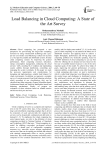
Load Balancing in Cloud Computing: A State of the Art Survey
Статья научная
Cloud computing has proposed a new perspective for provisioning the large-scale computing resources by using virtualization technology and a pay-per-use cost model. Load balancing is taken into account as a vital part for parallel and distributed systems. It helps cloud computing systems by improving the general performance, better computing resources utilization, energy consumption management, enhancing the cloud services' QoS, avoiding SLA violation and maintaining system stability through distribution, controlling and managing the system workloads. In this paper we study the necessary requirements and considerations for designing and implementing a suitable load balancer for cloud environments. In addition we represent a complete survey of current proposed cloud load balancing solutions which according to our classification, they can be classified into three categories: General Algorithm-based, Architectural-based and Artificial Intelligence-based load balancing mechanisms. Finally, we propose our evaluation of these solutions based on suitable metrics and discuss their pros and cons.
Бесплатно
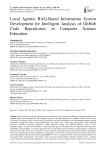
Статья обзорная
This study presents the development and evaluation of a local agent-based Retrieval-Augmented Generation (Agentic RAG) system designed for the intelligent analysis of GitHub repositories in computer science education and IT practice. The novelty of this work lies not in inventing a new RAG algorithm, but in orchestrating multiple existing components (LangChain, Redis, SentenceTransformer, and LLMs) into a multi-stage agent pipeline with integrated relevance evaluation, specifically adapted to offline repository mining. The proposed pipeline consists of four sequential stages: (1) query reformulation by a dedicated LLM agent, (2) semantic retrieval using SentenceTransformer embeddings stored in Redis, (3) response generation by a second LLM, and (4) relevance scoring through a verification agent with retry logic. Relevance is assessed via cosine similarity and LLM-based scoring, allowing iterative refinement of answers. Experimental testing compared the system against two baselines: keyword search and a non-agentic single-stage RAG pipeline. Results showed an average MRR@10 of 0.72, compared to 0.48 for keyword search and 0.61 for non-agentic RAG, representing a 33% relative improvement in retrieval quality. Human evaluators (n=15, computer science students) rated generated explanations on a 5-point Likert scale; the proposed system achieved an average 4.3/5 for clarity and correctness, compared to 3.6/5 for the baseline. Precision@5 for code retrieval improved from 0.54 (keyword) and 0.67 (non-agentic RAG) to 0.76 in the proposed system. Average query latency in the local environment was 3.8 seconds, indicating acceptable performance for educational and small-team IT use cases. The system demonstrates high autonomy by operating fully on-premises with only optional API access to LLMs, ensuring privacy and independence from cloud providers. Ease of use was measured through a System Usability Scale (SUS) questionnaire, yielding a score of 78/100, reflecting positive user perception of the Streamlit interface and minimal setup requirements. Nevertheless, several limitations were observed: the high computational cost of running embeddings and LLMs locally, potential hallucinations in generated explanations (particularly for complex or unfamiliar code), and the inability of vector search to fully capture code syntax and control flow structures. Furthermore, while the Analytic Hierarchy Process (AHP) was applied to select the system architecture, future work should complement this with benchmark-driven evaluations for greater objectivity. The contribution of this study is threefold: (1) introducing a multi-agent orchestration logic tailored to educational code repositories; (2) empirically demonstrating measurable gains in retrieval quality and explanation usefulness over baselines; and (3) highlighting both opportunities and limitations of deploying autonomous RAG systems locally. The proposed technology can benefit IT companies seeking secure in-house tools for repository analysis, universities aiming to integrate intelligent assistants into programming courses, and research institutions requiring reproducible, privacy-preserving environments for code exploration.
Бесплатно
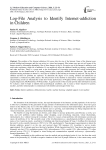
Log-File Analysis to Identify Internet-addiction in Children
Статья научная
The problem of the Internet addiction (IA) arose after the rise of the Internet. Some of the Internet users include children and teenagers and they are active in a virtual environment. Most minor users are not well aware of the dangers posed by information abundance. One of these dangers is the IA. Excessive use of the Internet is addictive, and some users experience a high risk of addiction. IA can negatively affect the children's health, psychology, socialization and other activities. There is a great need to the development of forecasting programs and various technological approaches for the identification of IA among Internet users, especially children and adolescents. This article uses machine-learning techniques to detect IA. Activities of children in the Internet environment is analyzed. The log-files of children and their IA problem are explored. To determine the degree of IA among children and adolescents an experiment is conducted on public dataset. The effectiveness of the methods is analyzed by various evaluation metrics and promising results are obtained.The results show better performance of Weighted SVM, compared to BernoulliNB, Logistic Regression, MLPClassifier, SVM classifiers. Acquired results of the research provide kids information security. To evaluate a kids IA helps to identify their psychological conditions, and it creates a better situation for parents, teachers, and other related people to communicate with children and teenagers better way.
Бесплатно
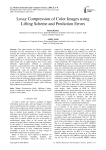
Lossy Compression of Color Images using Lifting Scheme and Prediction Errors
Статья научная
This paper presents an effective compression technique for lossy compression of color images. After reducing the correlation among R, G and B planes using YCoCg-R transform, the Integer Wavelet Transform (IWT) is applied on each of the transformed planes independently up to a desired level. IWT decomposes the input image into an approximation and several detail subbands. Approximation subband is compressed losslessly using prediction errors and Huffman coding, while each of the detail subbands are compressed independently using an effective quantization and Huffman coding. To show the effectiveness of proposed scheme, it is compared with several existing schemes and a state of art for image compression JPEG2000 and it is observed that the proposed scheme outperforms over the existing techniques and JPEG2000 with less degradation in the quality of reconstructed images while achieving high compression performance.
Бесплатно
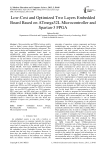
Статья научная
Microcontrollers and FPGAs both are widely used in digital system design. Microcontroller-based instruments are becoming increasingly widespread. This paper presents design and implementation of a new low-cost and minimum embedded board based on ATMEGA32L AVR microcontroller and Spartan-3 (XCS400-4PQG208C) FPGA in two layers with mount elements on top and button of board. Using of AVR microcontroller in proposed board it adds many features include Analog to Digital Converter (ADC), Digital to Analog Converter (DAC), 32 Kbytes flash memory, 2 Kbytes SRAM, 1024 bytes EEPROM memory. The design goal was to implement as many as possible low-cost and minimum size of the board, also to receive and process input signals in a short time period as real time. The board features are; mount elements in two side of the board for minimization of proposed board and also place decoupling capacitors (by pass) for the FPGA in bottom layer of board strictly below this IC because they should be placed as close as possible to the power supply pins FPGA, use GND polygon layer in total top layer and microcomputer ground for FPGA in bottom layer, use two RS-232 serial port, one VGA connector, PS/2 serial port, and SPI serial port on FPGA, use MT48LC16M16A SDRAM-256MB(4*4MB*16), and XCF02S configuration PROM. Size of the proposed embedded board is 10cm*15cm thus this board was optimized of aspect cost, performance, power, weight, and size.
Бесплатно
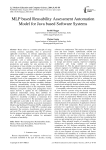
MLP based Reusability Assessment Automation Model for Java based Software Systems
Статья научная
Reuse refers to a common principle of using existing resources repeatedly, that is pervasively applicable everywhere. In software engineering reuse refers to the development of software systems using already available artifacts or assets partially or completely, with or without modifications. Software reuse not only promises significant improvements in productivity and quality but also provides for the development of more reliable, cost effective, dependable and less buggy (considering that prior use and testing have removed errors) software with reduced time and effort. In this paper we present an efficient and reliable automation model for reusability evaluation of procedure based object oriented software for predicting the reusability levels of the components as low, medium or high. The presented model follows a reusability metric framework that targets the requisite reusability attributes including maintainability (using the Maintainability Index) for functional analysis of the components. Further Multilayer perceptron (using back propagation) based neural network is applied for the establishment of significant relationships among these attributes for reusability prediction. The proposed approach provides support for reusability evaluation at functional level rather than at structural level. The automation support for this approach is provided in the form of a tool named JRA2M2 (Java based Reusability Assessment Automation Model using Multilayer Perceptron (MLP)), implemented in Java. The performance of JRA2M2 is recorded using parameters like accuracy, classification error, precision and recall. The results generated using JRA2M2 indicate that the proposed automation tool can be effectively used as a reliable and efficient solution for automated evaluation of reusability.
Бесплатно
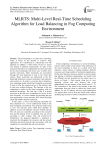
MLRTS: multi-level real-time scheduling algorithm for load balancing in fog computing environment
Статья научная
Cloud computing is an innovative technology which is based on the internet to preserve large applications. It is warehoused as a shared data over one platform. In addition, it offers better services to clients who belong to different organizations. In spite of the maximum utilization of computational resources provided by the cloud computing with lower cost, it suffers from specific restrictions. These restrictions are encountered through the load balancing of data in the cloud data centers. These restrictions are represented in the less bandwidth utilization, resource limitations, fault tolerance and security etc. In order to overcome these limitations, new computing model called Fog Computing is presented. It aims to offer the required service of the sensitive data to end users without delaying. The function of the fog computing is similar to the cloud computing with two preferred advantages. The first one is that it is placed more near to the end users to introduce its service in less time. Secondly, it is more valuable for streaming the real time applications, sensor networks, IOT which need high speed and reliable internet connection. In this paper, a novel load balancing algorithm has been proposed over a novel architectural model in the Fog Computing environment. The proposed model aims to serve the real-time tasks within their deadline. In addition, it serves the different soft tasks without starving. The soft tasks are classified according to the execution time and the priority levels. In addition, they are served according to their waiting time and priority-level. Furthermore, the proposed algorithm is employed to maximize the throughput, the resources and the network utilization and preserving the data consistency with less complexity to accomplish the end users demand.
Бесплатно
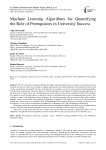
Machine Learning Algorithms for Quantifying the Role of Prerequisites in University Success
Статья научная
The use of machine learning algorithms for higher education performance assessment is an emerging area of research and several works have focused on student performance and related problems. The preliminary goal of this work is to determine and quantify the role of prerequisites in academic success by using machine learning algorithms with the Weka environment. The main objective is the development of a tool based on machine learning algorithms for the prediction of future results for a training program based solely on the previous academic profiles of the students. The interest is to link whether success in previous courses is associated with success in subsequent target courses. This will help to improve the planning of course sequences in a training program on the one hand and the overall academic students’ success on the other. The proposed methodology is applied for the analysis of the role of the prerequisites influencing courses success of a training course in Mathematical and Computer Sciences in a Moroccan university. For this purpose, we use several classification algorithms such as Random Forest, J48, and Multilayer Perceptron. Preliminary results show that the correlation between the prerequisite reliability rates of the courses studied and the accuracy with which the learning algorithms predict the success outcomes of these courses is confirmed. Also, these results show that the best accuracy and the best Receiver Operator Characteristic ROC area are obtained by using Random Forest algorithm and have reached 86% for the accuracy and 75.6% for the ROC area.
Бесплатно
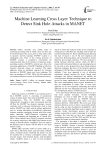
Machine Learning Cross Layer Technique to Detect Sink Hole Attacks in MANET
Статья научная
Adhoc networks uses mobile nodes to communicate among itself in which it does not have any fixed infrastructure like access point or base station. Due to dynamic network topology MANET security is a challenging task. Most of the routing protocols in MANET assumes a cooperative environment for communication. But, in the presence of malicious nodes, providing security to MANET is critical issue. Due to the increasing applications of MANET building an effective intrusion detection system are essential. This paper addresses using an intelligent approach for intrusion detection in MANET using cross layer technique. We show an paradigm of SVMs, FDAs and AIS approaches for intrusion detection in terms of classification accuracy.
Бесплатно
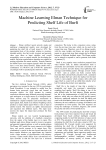
Machine Learning Elman Technique for Predicting Shelf Life of Burfi
Статья научная
Elman artificial neural network single and multilayer computerized models were developed for predicting the shelf life of burfi stored at 30ºC. The experimental data of the product relating to moisture, titratable acidity, free fatty acids, tyrosine, and peroxide value were taken as input variables, and overall acceptability score as output variable for developing the models. Bayesian regularization algorithm was applied as training algorithm for neural network. Transfer function for hidden layers was tangent sigmoid; while for output layer it was pure linear function. Elman model with a combination of 5→10→1 and 5→7→7→1 performed exceedingly well for predicting the shelf life of burfi.
Бесплатно
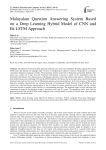
Статья научная
The Question-Answering (QA) approach represents one of the most significant Natural Language Processing (NLP) tasks that depends on language input. In terms of morphology & adhesive structure, Malayalam is a resource-constrained indigenous language of India. These linguistic features make QA in Malayalam particularly difficult. This study uses a subset of 5 tasks from the Facebook bAbI dataset to present a subset of five assignments from the Facebook bAbI dataset; this study presents a Malayalam Question Answering Solution that utilizes a Deep Learning (DL) hybrid framework combining CNN and Bi-LSTM Methods. We believe this is the initial time a hybrid-based deep learning framework has been used for the Malayalam question-answering technology. In the first iteration of the method, high-level semantic characteristics are extracted utilizing a Convolutional Neural Network. The Bi-LSTM tier then extracts the contextual feature representation of the text using the feature extraction result. Finally, use the softmax activation function to predict correct answers for corresponding questions. The proposed model is both functional and systemized in terms of classification accuracy, precision, recall, and F1 scores. The simulation results show that the proposed hybrid CNN and Bi-LSTM model outperform the existing models in terms of classification with more than 91 % accuracy for all five tasks.
Бесплатно

